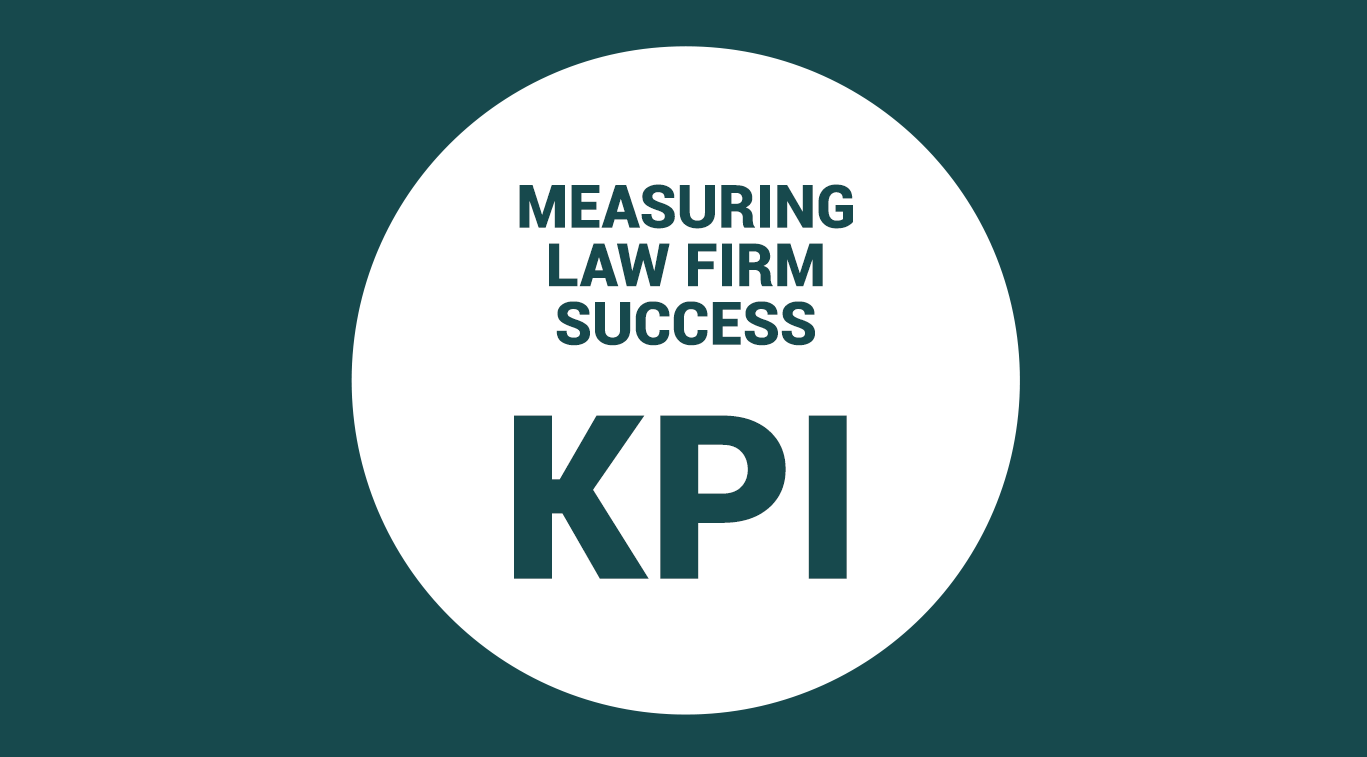Measuring Law Firm Success: Key Performance Indicators

Written by Maryam Khan
Blogger

Managing and tracking business growth, profitability, expenses, and a law firm’s overall performance is crucial to ensure its success. Doing so requires identifying, monitoring and acting on key performance indicators (KPIs). Law firms use several useful KPIs for their business depending on their size, structure and specialism. Understanding a law firm’s performance allows business leaders and managers to identify strengths and weaknesses to improve areas and optimise efficiency. Having access to this knowledge and acting on the data generated allows law firms to maintain their competitive edge, improve their market position and stay ahead of the game. However, it can be complicated to determine how this information should be collected, stored, and processed. This is where the role of technology in the legal sector comes into play as the use of KPI dashboards, practice management systems and knowledgement management software and other legal technology solutions ensure that KPIs are being tracked and monitored successfully. This article outlines how law firms can use KPI software to ensure that all findings are reported in an organised way so they are easily understood and accessed by law firm management.
What are key performance indicators?
Key performance indicators refer to quantifiable data used to evaluate business performance and success [1]. These performance indicators are metrics used to evaluate specific goals and aspects of a law firm’s success. They need to be measurable and align with the law firm’s long-term and short-term goals to ensure they are relevant and add value to the business. There are hundreds of key performance indicators a law firm can choose to monitor. However, the number of metrics you choose to track is not important and, in fact, be quite inefficient as tracking way too many indicators can be complicated, time-consuming and confusing. Therefore, identifying and choosing the right performance indicators is extremely important. If law firms select key performance indicators that cannot be measured and do not match their business goals, the data gathered can be a waste of time and can hinder the firm’s growth [2].
SMART KPIs, SMART-ER KPIs & Vanity Metrics
“SMART” key performance indicators stand for those that are Specific, Measurable, Attainable, Relevant and Time-Bound [3]. The goals law firms wish to achieve need to be “SMART” to ensure that they are realistic, quantifiable, and periodically monitored. Here, the questions that need to be asked when discussing which KPIs to monitor include the following:
- What does the law firm aim to achieve? (Specific)
- What data can be used to quantify performance? (Measurable)
- Is this goal possible to accomplish? (Achievable)
- Is the goal aligned with the law firm’s business goals? (Relevant)
- Does achieving the goal have a time frame? (Time-Bound)
Therefore, simply aiming to increase profits is not sufficient. However, aiming to increase profits by 20% by the next financial year meets the ‘SMART’ KPI criteria as there is a clear KPI involved; the percentage increase in profits compared to last year [4]. Not only does this method provide a structured goal, but it also allows law firm management to monitor goals that actually reflect the performance of the business.
This process avoids ‘vanity metrics’, which may look positive on the surface but do not help law firms actually understand their performance in a way that informs future strategies for business growth [5]. Examples of vanity metrics include the overall number of clients, website visits or how much the firm budget is spent on marketing. The amount of money spent on a marketing budget adds no value to law firms without understanding the return on the investment or the difference in revenue earned before and after marketing campaigns [6].
Lastly, many firms have started to incorporate ‘SMART-ER’ KPIs. This includes the practice of ‘Evaluating’ and ‘Revising’ current KPIs [7]. A law firm’s business goals will change according to the commercial climate, making it important to evaluate whether a particular KPI is providing the right measurements or whether it is still aligned with its business goals. Moreover, KPIs will not always stay the same as a firm’s business priorities may change. Therefore, it is important to revise KPIs to ensure they are relevant and reflect the firm’s future goals.
What KPIs Should Law Firms Measure?
Getting started on choosing the right KPIs to measure includes a performance analysis over the previous years to spot improvements and develop new business goals. The most relevant and valuable KPIs are selected, tracked, and monitored depending on these business goals. However, here are a few KPIs law firms can start working on regardless of their size, practice areas and business development plans [8].
Utilisation & Billability Rate
A lawyer’s utilisation or billability rate measures how much of their time is spent on work that is billable to clients [9]. This rate is extremely important to understand each employee’s level of productivity. The utilisation rate is calculated by dividing a lawyer’s billable hours by the total hours worked. For example, if a lawyer works 3000 hours in a year and bills 2300 hours, their utilisation rate for the year is 77%. This simply means that 77% of that lawyer’s time was spent on work that is billable to clients [10]. This allows law firms to make important hiring decisions as it enables HR teams within the firm to assess whether it is necessary to hire new employees to manage the current workload [11]. While these decisions are not solely made on a percentage, monitoring and reporting data on employee productivity levels and utilisation rate is important.
Client Acquisition
New clients are crucial to the success of a law firm as a regular inflow of client work results in higher revenue streams. Therefore, law firms have multiple client acquisition strategies at play that market the firm’s services to prospective clients. Keeping track of this KPI allows law firms to understand how effective their marketing campaigns are and whether they are making the right investment. If the client acquisition rate per month keeps increasing, this is a good sign. However, suppose the rate stays stagnant or declines. In that case, law firms should allocate their resources elsewhere to be more efficiently used. Client acquisition KPIs include all the costs associated with bringing a new client to the law firm [12].
Client Development
Client development rates examine all activities carried out for existing clients [13]. This includes monitoring all communications with clients to manage the law firm’s relationship with them and meet their expectations. Aspects to measure when calculating a client development rate include the average revenue per client, the number of lawyers allocated per client, the number of matters being worked on within a week or a month, the average fee for a new client and also the average monetary value of closed cases [14]. Additionally, law firms can also use a client development rate to understand and measure the growth of their client portfolio. Points to consider when calculating the client growth rate include whether or not this rate wants to be calculated for the firm as a whole or for each practice area.
Social Media Engagement
The engagement rate measures the amount of interaction a law firm’s social media content or email campaigns receive and whether the firm’s target audience has been reached [15]. These metrics include likes, comments, shares and click-throughs. An engagement rate is calculated by dividing the total engagements by the impressions on a social media post. While having high social media engagement was not seen as a high priority by traditional law firms, email marketing and social media campaigns are becoming increasingly popular amongst law firms looking to boost their competitive edge. This ensures that law firms produce content relevant to their target audience resulting in more clients being interested in the services the firm has to offer.
Net Profitability Margin
Maintaining profitability requires revenue to exceed costs consistently. Therefore, law firms should have a key performance indicator for their revenue, expenses and profitability to determine their net profit margin. This includes subtracting all operating expenses from the total revenue generated within a financial year or quarter. Operating expenses include travel expenses, court filing fees, payroll, office expenses, and IT services. Monitoring a law firm’s operating expenses ensures that expenses do not increase and are kept well within the budget. Moreover, law firms can identify where most of their money is being spent and allocate their budget elsewhere depending on their business goals and plans. Lastly, having an in-depth understanding of the firm’s spending patterns allows law firm management to discover areas where more profit can be generated [16].
Employee Satisfaction
Employee satisfaction is equally as important as client satisfaction. Employee satisfaction is crucial to ensure that legal departments remain productive and happy when working. Data collected by the London School of Economics found that higher employee wellbeing is associated with higher productivity. Therefore, the happier employees are, the more efficiently they work, resulting in higher revenue for law firms [17]. Aspects to include in this KPI include the law firm’s turnover rate, successful hires after a trial period, employee satisfaction index, and internal promotion rate [18].
What is the best way to track KPIs?
KPI Dashboards
KPI dashboards are tools that merge data sources to provide a visual board that highlights a business’ performance against its key performance indicators [19]. This is done through the KPI dashboard’s easy KPI and business metrics tracking solutions, customizable data visualisation features, and unified law firm data [20]. A visual dashboard of all firm data is a great way to manage and track metrics by analysing their real-time progress against the law firm’s goals.
Moreover, KPI dashboards are completely customizable and can be altered depending on how a lawyer works and the tools and features they want to incorporate into their layout. Through KPI dashboards, law firms can also get direct one-click access to information relating to particular clients and cases [21]. Lastly, KPI dashboards exist to make understanding a law firm’s process extremely simple and easy without involving too many calculations, numbers and percentages. For example, KPI dashboards answer simple questions like ‘Were the firm’s billable hours target met this month?’ or ‘Were all expenses under the budget for this quarter?’.
Practice Management Systems
Legal practice management systems can help law firms track their key performance indicators. This ensures that firm-wide information is automatically collected so lawyers can focus on practising law instead of getting too involved with information management, calculating and identifying trends. Using legal practice managements solutions allow law firms to have access to information relevant to each of their practice areas in an organised and easy to understand manner. Legal data analytics functions within practice management systems allows law firm data to be periodically analysed to identify trends and patterns within the firm’s activities.
Knowledge Management Systems
Law firm knowledge management software collects, stores and organises law firm data to improve understanding and collaboration [22]. Using knowledge management systems to track information used to calculate KPIs is more efficient than manually storing data on excel spreadsheets. Having a system that automates data collection and trend identification ensures less room for human error and makes the whole process of tracking and monitoring KPIs less complicated. Moreover, legal IT solutions embedded in knowledge management systems facilitate document management, distribution of information and data storage which is key for information monitoring when calculating KPIs.
Final Words
A key performance indicator-based approach can be extremely useful for law firms to track their progress and achieve their business goals. However, it can be overwhelming considering the amount of data and client information involved. Calculating, monitoring and identifying trends from this data manually can be a very complicated process. Therefore, it is always best to integrate legal practice management software or knowledge management systems within the business to collect, monitor and analyse law firm data to measure its key performance indicators. Utilising legal technology allows law firms to work towards their goals in a more efficient and sustainable way. There are more advanced legal solutions that focus on calculating, measuring, and monitoring KPIs that many leading law firms have started to invest in. If you are looking to measure the performance of your law firm, adopting a key performance indicator strategy is your best option.
References
[1] Eden Bright, ‘5 Growth KPIs Your Law Firm Should Track’, Lex Reception (2021) at https://www.lexreception.com/blog/business-tips/law-firm-kpis/
[2]
[3]Patrick Ward, ‘Smart KPI: Business Definition and Usage’, Nano Globals (2022) at ‘https://nanoglobals.com/glossary/smart-kpi-definition/#:~:text=The%20acronym%20%E2%80%9CSMART%20KPI%E2%80%9D%20stands
[4] Ibid (1)
[5] ‘Vanity Metrics: Definition, How To Identify Them, And Examples’, Tableau at https://www.tableau.com/learn/articles/vanity-metrics#:~:text=What%20are%20vanity%20metrics%3F,way%20that%20informs%20future%20strategies.
[6] Kevin Cheung, ‘Vanity Metrics For Lawyers’, Canadian Lawyer at https://www.canadianlawyermag.com/news/opinion/vanity-metrics-for-lawyers/275445
[7] Stuart Kinsey, ‘Using a SMARTER Criteria for Better KPI Dashboards’, Simple KPI (2017) at https://www.simplekpi.com/Blog/SMART-and-SMARTER-KPI-Dashboards
[8] Jeremy Beam, ‘What Are the Key Performance Indicators (KPIs) that Matter for Your Firm’s Success?’, NJALA at https://www.njala.net/index.php?option=com_dailyplanetblog&view=entry&year=2018&month=08&day=20&id=7:what-are-the-key-performance-indicators-kpis-that-matter-for-your-firm-s-success-
[9] Liz Lamar, ‘Law Firm Profitability Analysis: Key Metrics All Firms Should Consider’ ALM egal Tech Newsletter at https://blog.affinityconsulting.com/93-focused-on-more-productivity-higher-firm-profits
[10] Ibid
[11] Andrei Costea, ‘KPI of the Day – Business Consulting (BC): % Employee Utilization Rate’, Performance Magazine (2021) at https://www.performancemagazine.org/kpi-day-business-consulting-bc-employee-utilization-rate/
[12] Natella Mammadzadeh, ‘Top 7 Law Firm KPIs to Evaluate Your Business Success’, Booknetic (2021) at https://www.booknetic.com/blog/law-firm-kpis
[13] Ibid
[14] Ibid
[15] Kristyn Brophy, ‘Five Essential KPIs for Measuring Your Law Firm’, Jdsupra (2022) at https://www.jdsupra.com/legalnews/five-essential-kpi-s-for-measuring-7860116/
[16] ‘5 Key Performance Indicators (KPIs) For Law Firms’, Lego Desk at https://legodesk.com/legopedia/5-kpis-that-a-law-firm-should-measure/
[17] Christian Krekel, George Ward, Jan-Emmanuel De Neve, ‘ Happy Employees and their impact on firm performance’, London School of Economics at https://blogs.lse.ac.uk/businessreview/2019/07/15/happy-employees-and-their-impact-on-firm-performance/
[18] ‘Top 10 Employee Engagement KPIs’, LumApps at https://www.lumapps.com/blog/employee-engagement/employee-engagement-kpis/
[19] ‘What are KPI dashboards’, Power BI Microsoft at https://powerbi.microsoft.com/en-us/kpi-dashboards/#:~:text=KPI%20dashboards%20are%20tools%20that,KPIs%20and%20other%20business%20metrics.
[20] Ibid
[21] ‘KPIs For Your Law Firm’ – Legal Technology, Practice Management, Uncategorised at https://www.amicusattorney.com/blog/kpis-for-your-law-firm/
[22] ‘Knowledge Management Systems: The Ultimate Guide’ Hubspot at https://www.hubspot.com/knowledge-management-systems








